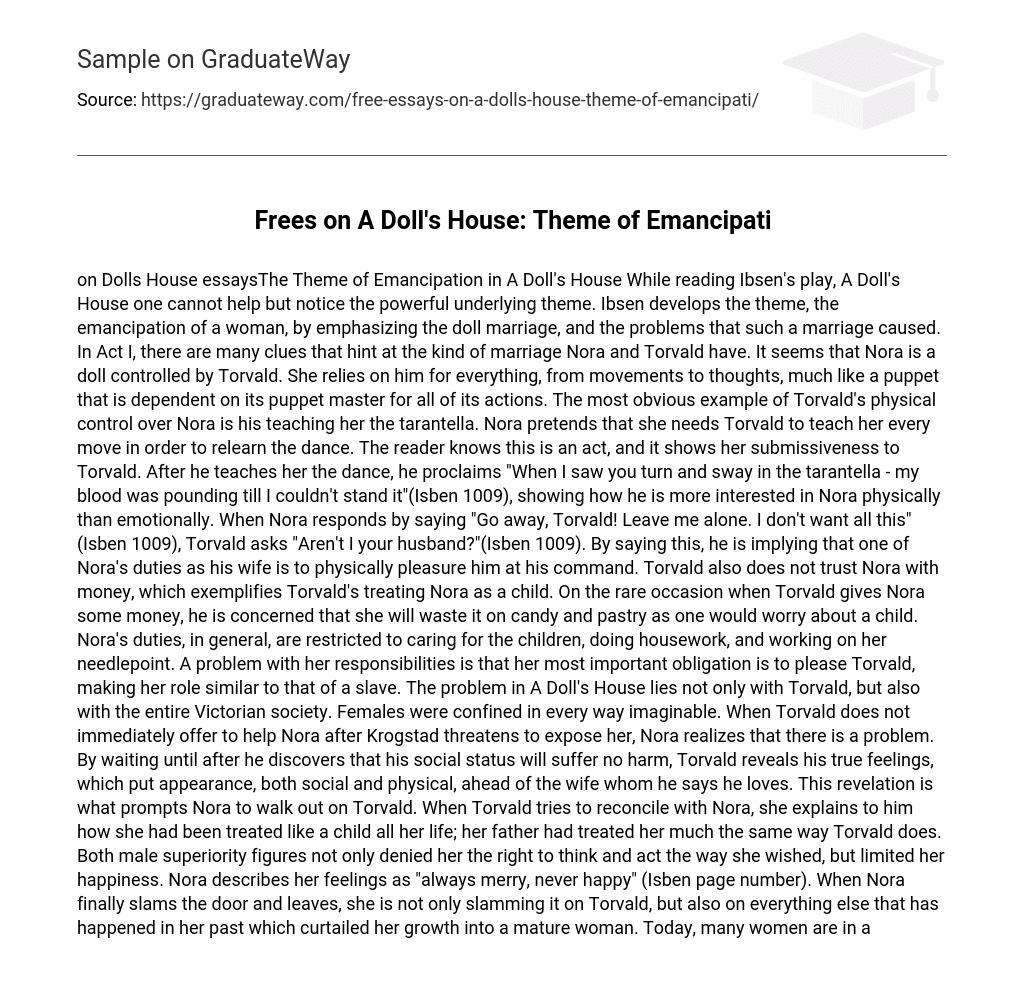The central theme of A Doll’s House by Ibsen is the emancipation of women, which is evident throughout the play.
Ibsen explores the theme of women’s emancipation by highlighting the issues stemming from a doll-like marriage. In Act I, various hints suggest the dynamics of Nora and Torvald’s relationship. Nora appears to be a puppet under Torvald’s control, relying on him for everything – actions, thoughts, and more. The most visible indication of Torvald’s physical dominance over Nora is his instruction of the tarantella, with Nora pretending to require his guidance for every step in relearning the dance.
It is evident to the reader that this is a performance by Nora, displaying her submissiveness towards Torvald. He teaches her the dance and declares that when he saw her perform the tarantella, it evoked intense physical desire in him. This showcases his attention towards Nora’s physical appearance rather than her emotional well-being. In response, Nora pleads with Torvald to leave her alone and expresses her disinterest in the situation. Torvald then questions Nora by asking if he is not her husband.
By stating this, he is implying that Nora’s obligation as his wife is to satisfy him physically whenever he desires. Torvald also lacks confidence in Nora’s handling of money, which highlights his treatment of Nora as a child. When Torvald occasionally gives Nora some money, he is concerned that she will squander it on sweets and pastries, just like one would fret about a child. Nora’s responsibilities mainly revolve around taking care of the children, housework, and working on her needlework. One issue with her duties is that her most crucial duty is to please Torvald, mirroring the role of a slave.
The issue in A Doll’s House arises not only from Torvald but also from the entire Victorian society. Women were restricted in every possible way. When Krogstad threatens to reveal Nora’s secret, Torvald’s lack of immediate assistance makes Nora realize the problem. Waiting until after he finds out that his social standing will be unaffected, Torvald exposes his true sentiments, prioritizing appearances, both social and physical, over his supposedly beloved wife. It is this revelation that prompts Nora to leave Torvald.
Nora tells Torvald that she had been treated like a child her whole life, similar to how her father treated her. Both men not only denied her freedom of thought and action, but also limited her happiness. Nora describes her emotions as always being cheerful but never truly content. When Nora slams the door and leaves, she is not just leaving Torvald, but also leaving behind a past that hindered her growth into a mature woman. Today, many women find themselves in a similar situation as Nora. Although some have accepted women as equals, there are still those who cling to outdated societal views.
The text argues that achieving true equality is challenging due to the demands of Christian conservatives for women to conform to traditional roles and some women using their “feminine charm” to manipulate men. These mindsets are evident in the play A Doll’s House. Torvald exemplifies the modern stereotypical man, focused on his image and exerting control without considering others’ emotions. Nora, in contrast, represents the typical woman who caters to men’s desires.
She manipulates Torvald into believing he is smarter and stronger than he actually is, but when Nora slams the door, Torvald realizes the true meaning of love and equality. He understands that being together with someone like Nora won’t achieve true equality. Only when everyone in the modern world perceives males and females as fully equal, without using their societal power based on their gender, can true equality exist.
Work Cited: Ibsen, Henrik.
Four Major Plays: A Doll’s House, Ghosts, Hedda Gabler, The Master Builder. New York: Oxford University Press, 1998.





